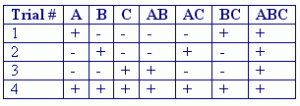ALIAS
In experimental design, Aliasing occurs when the effect of an input factor or interaction is likely to be mistaken for or ‘diluted’ by the effects of other input Factors or Interactions. This phenomenon, also known as ‘confounding’, is a result of fractionated designs which use a very small number of experimental trials to estimate all the factor effects and Interactions.

The table alongside shows a half fraction of a 2-level, 3-factor design with 4 trials.
Each of the columns, AB, AC, BC and ABC are formed by taking the product of the signs of the constituting columns A, B and C. For example, column BC is formed by multiplying the signs of columns B and C together: (-*-) = +, (+*-) = -, (-*+) = -, (+*+) = +.
Column ABC is the product of columns A, B and C. If you examine the table closely, you will find that the column A is identical to column BC, column B is identical to column AC and column C is identical to column AB.
When these effects are estimated using the data from the 4 trials, main effect A will be indistinguishable from interaction BC, and similarly, B from AC and C from AB. Thus, A and BC are aliased, as are B and AC and C and AB.
Application
The degree to which the effects in a design are aliased is represented by the Resolution of the design. In the previous design, main (1-factor) effects are aliased with 2-factor interactions, hence it is a Resolution III (3 in Roman numerals) design. Similarly, designs in which main effects are aliased with 3-factor interactions and 2-factor interactions are aliased with each other, are called Resolution IV (4) designs. The best designs are those with a resolution of IV or higher, since then the main effects and smaller-order interactions are only aliased with much higher order interactions, essentially freeing them from aliasing (3-factor and higher order interactions are usually considered negligible for practical purposes).
